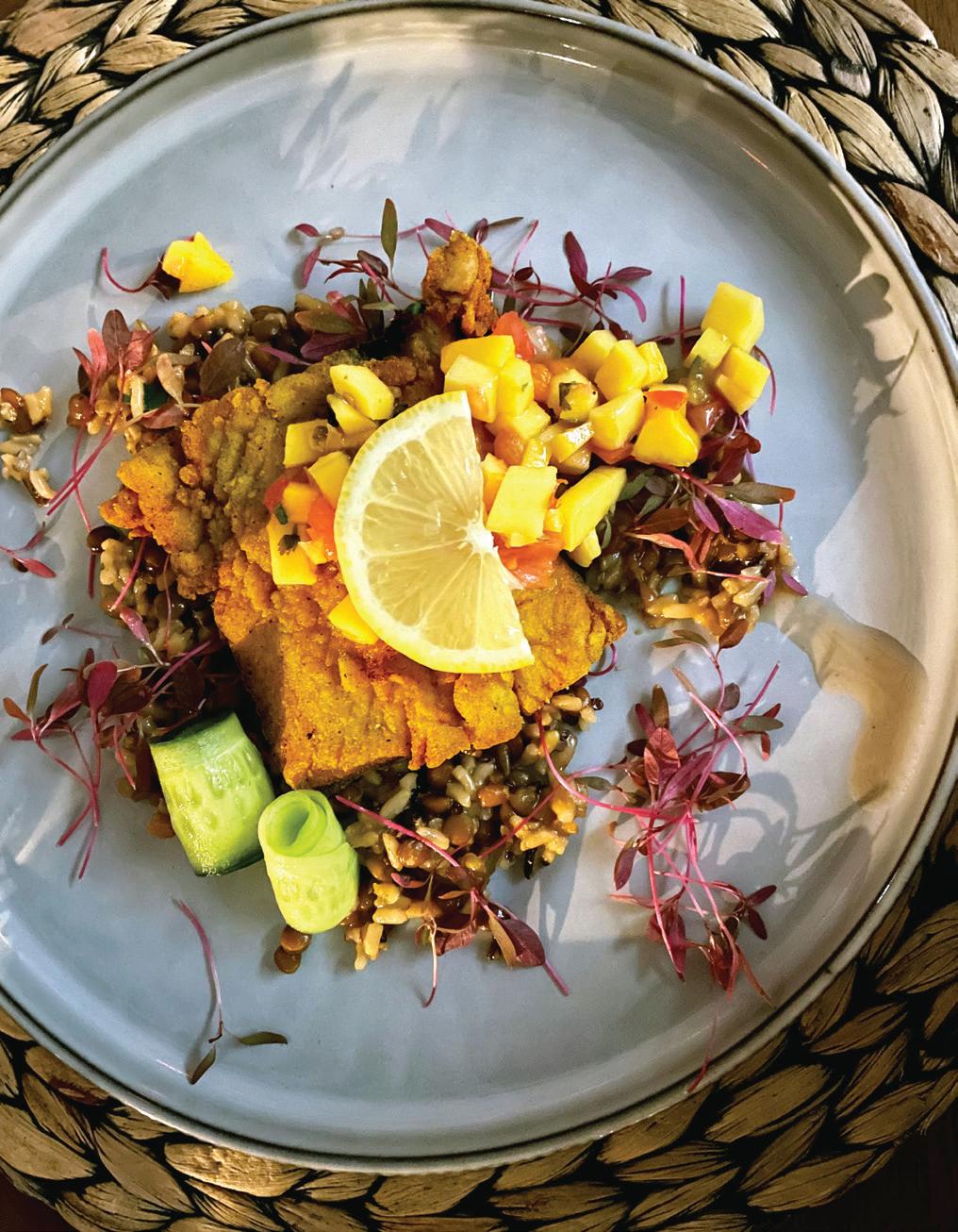8 MINUTE READ
Make The Most Of Great Lakes Fish
Next Article
Katie L. Grant
Katie L. Grant is communications director for the DNR.
Have you ever had pickled sucker? It’s one of the more unique fish to eat in Wisconsin, and food stylist and chef Stef Endres of Simply Food Styling has no shortage of stories about doing so.
She claims to have never found a fish she doesn’t like and compares this delightful spring nibble to be “a little bit like herring … not lutefisk, that’s gross.” So maybe she has found one fish, or preparation of it, that she doesn’t like.
Endres grew up in southern Germany, in a part of the country that feels very much like it could be southern Wisconsin. And if you had asked her parents, they’d have described her as a “forest child,” she said, always bringing home animals and playing outside in the forest across from her house.
Endres said she’s always been naturally drawn to the outdoors. “I think it has something to do with almost a spiritual journey whenever I’m in nature, especially in the woods and on the water. It just gives me serenity. There’s a freedom and peace watching the sun rise on the river.”
As a young adult, she became interested in journalism and writing, eventually moving to Heidelberg for a photography program. While there, she worked for a hotel and restaurant that housed American soldiers.
In 1998, a journalist unit from Madison arrived and began to joke that Endres should visit the U.S. and study there for fun. She was just about to graduate, so she figured, “Why not?” and applied to a program in La Crosse to learn more about photography and art.
One thing led to another — she met her future husband, and the rest is history.

FOOD AND THE OUTDOORS
When talking to Endres, it feels like she’s lived 10 lifetimes and always has a story to tell that has the listener on the edge of their seat. She’s moved halfway around the world and has collected many unique life experiences.
Endres was the first food stylist in the photo studio for Swiss Colony, the food gifts company based in Monroe. She’s had a pig farm, and a cheese and sausage store she owned with a friend in Paoli, where she butchered her own animals to make the sausage they sold. She’s started to write a children’s book and a cookbook, she’s done catering, and the list goes on.
But through it all, her love of food and the outdoors has been there.
“I cannot remember a time when we did not help out cooking. My mom was always very open about getting us kids in the kitchen,” Endres said. “The earliest memory of food I have is my grandma’s Christmas goose. When I close my eyes and I think about it, I can smell it.
“Food memories have a lot to do with smell — I can walk through a place outdoors, and I smell something, and it can revive a memory of cooking or food. Food is just something that always came naturally to me. At the end of the day, I just hope my food makes people happy.”
If you’re looking for Endres, try heading down to the local river. After returning from Germany when her mother died, Endres found it was spending time on the Sugar River that brought her serenity.
“Being on the river in the moonlight and kayaking, and all you hear is the animals around you and the sound of your paddle,” she said. “There’s just something about it.”
COOKING KEPT SIMPLE
While on the water, she’ll fish for anything, though her hands-down favorite is catfish from the Sugar River because of its sandy bottom. When she’s in Germany, it’s barsch, or Perca fluviatilis (European perch), a fish that’s very common in lakes in Austria and Germany.
Endres encourages those fishing Wisconsin’s waterways to keep simplicity in mind when cooking their catch. Her favorite method is pan frying in half butter and oil with some eggs and breadcrumbs, salt, pepper and paprika, plus maybe some Greek seasoning and lemon.
She also subscribes to the motto that if you catch it, try to find a way to eat it.
That might mean whipping up a northern meunière, a French method that includes brown butter, parsley and lemon. Or maybe try smoked lake trout tartare or cucumber vichyssoise with poached lake trout, as you’ll find on the next pages — both are much easier for the home chef to make than their names imply.
These recipes were created by chef Stef Endres for the Wisconsin DNR as part of a campaign funded by the federal CARES Act to promote commercially caught fish in Wisconsin.
Wisconsin’s Great Lakes fisheries are carefully managed for sustainability through regulation and monitoring. When shopping or eating at restaurants, look for lake trout, lake whitefish, cisco and yellow perch from Wisconsin. Or catch your own — it’s easy when you head out on the big lakes with the help of a Wisconsin fishing charter! To learn more about enjoying Great Lakes fish, visit dnr.wisconsin.gov/ChooseGreatLakesFish.
Smoked Lake Trout Tartare
INGREDIENTS
4 oz cream cheese
1/2 cup heavy whipping cream
4 oz smoked lake trout, torn into pieces
1/2 lemon, juiced
2 mini cucumbers, seeded and finely diced
2 tablespoons prepared horseradish
1 tablespoon fresh dill, chopped
1 teaspoon paprika
Salt and pepper to taste
4 slices pumpernickel bread
DIRECTIONS
- Beat the cream cheese until soft. Separately, beat the heavy whipping cream until stiff peaks have formed.
- With a spatula, combine cream cheese, whipped cream, smoked lake trout, lemon juice, diced cucumbers, horseradish, dill and paprika. For a smoother texture, blend together using a blender.
- Season with salt and pepper to taste. Chill for at least 30 minutes before serving.
- This appetizer can be served as a dip with pieces of pumpernickel bread. Or cut pumpernickel into rounds and make into finger sandwiches, topping with thinly sliced cucumber, a dollop of whipped cream and a sprig of dill.

Lake Michigan Whitefish With Ancient Grains
INGREDIENTS
4 6-8 oz portions of whitefish fillets
1/2 lemon
1 tablespoon salt
1 teaspoon black pepper
1 teaspoon Cajun seasoning
Cornmeal flour to dip the fish
1 1/2 cups ancient grain mix (can be store-bought mix or make your own with quinoa, amaranth, chia seeds or rice to your liking)
1 cup vegetable stock
1 tablespoon ghee
1 tablespoon high-heat oil such as avocado oil
1 pouch (8 oz) prepared lentils
2 mini cucumbers, thinly sliced with a peeler into long ribbons
1 cup pink grapefruit segments
Salt and pepper to taste
Optional: fresh mango, pineapple or peach salsa for topping
DIRECTIONS
- Rub the lake whitefish fillets with the cut lemon and season with salt, pepper and Cajun seasoning on both sides. After seasoning, coat the fillets with fine cornmeal flour, lightly pressing down to adhere. Then gently shake the excess breading and set aside until ready to pan fry.
- Begin preparing the ancient grains by cooking according to package instructions, using vegetable stock in place of water.
- Using a large pan big enough for the fillets to avoid crowding, heat ghee and oil until hot. Test the heat of your oil with a wooden spoon – if it creates bubbles around your spoon, it’s hot enough.
- Add fish, pan frying over medium-high heat until golden brown, about 5-6 minutes per side. Fry in batches if needed to ensure fillets are not crowded in pan. Place the fish on paper towels to absorb excess grease.
- Once grains are cooked, combine with heated, cooked lentils.
- Add cucumbers and grapefruit segments. Season to taste.
- Divide the mixture onto plates and top with fish, serving immediately. If desired, top with a refreshing mango, pineapple or peach salsa.

Cucumber Vichyssoise With Poached Lake Trout
INGREDIENTS
8 oz lake trout fillet cut into 2 oz portions
1 cup ghee
Salt and pepper to taste
1 cup potatoes, peeled and cut into 1-inch chunks
2 tablespoons fresh dill
Optional: green onion or chives, lemon oil or ghee for garnish, crusty bread or puff pastry sticks.
DIRECTIONS
- Select a pot small enough to allow your fish pieces to be fully submerged but large enough they won’t be touching. Melt ghee in your pan on the lowest heat setting – use a thermometer to ensure the ghee doesn’t exceed 140F throughout the process.
- Season your fish on both sides using salt and pepper. Add to the pan and let poach for 8-10 minutes.
- While your fish poaches, add your potatoes to a pot and cover completely with water. Bring to a boil and let cook for 8-10 minutes or until soft throughout.
- Once potatoes are cooked, place them in a blender with coconut milk, whipping cream, vegetable stock, cucumber and dill. Blend on high until smooth. Season to taste with salt and pepper. For a brighter flavor, add 2 tablespoons of fresh green onion or chive.
- Chill for at least one hour or overnight. If chilling overnight, be sure to give the mixture a final blend before serving for a smooth texture.
- To plate, divide the chilled soup into shallow bowls. Place the poached fish in the center of each bowl. Garnish as desired with dill, chives, a drizzle of lemon oil or ghee and crusty bread or puff pastry sticks.

You may also like
-
Tradition Door County Fish Boil at Laack’s in Johnsonville, WI
-
GARLIC PARMESAN CRAPPIE by Timer 2 Table in Realtree Newsletter
-
EATING YOUR CATCH – MAKING HEALTHY CHOICES FISHING WISCONSIN
-
Got Fish For Dinner?
-
Kirstie Pike• 1stOwner/CEO Prois Hunting Apparel for Women and Founder/CEO Provider Outdoors- Lifestyle Clothing For Women Who PROVIDE!

